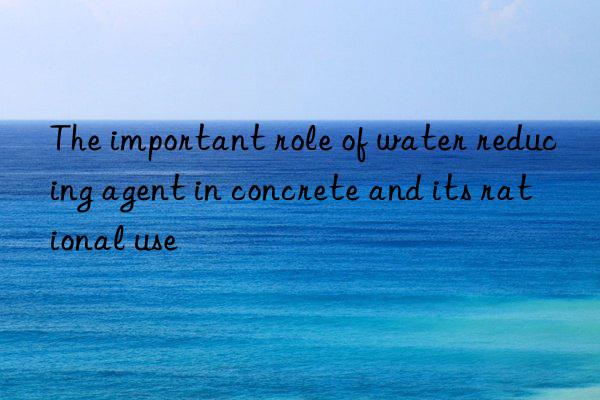
With the rapid development of the world economy, the construction industry has increasingly higher requirements for concrete. Since the beginning of the 20th century, the official use of admixtures has not only made a great contribution to the construction industry, but also has great benefits in other industries. Because ordinary water-reducing agents can improve the workability of concrete, reduce unit water consumption, change the setting time of concrete, change the process of hydration heat release, and reduce the bleeding and settlement of concrete, ordinary water-reducing agents are used in many projects. There are many types of ordinary water-reducing agents, and different water-reducing agents are suitable for different projects. Among ordinary water-reducing agents, the most commonly used water-reducing agent is lignocalcium water-reducing agent. This article mainly discusses the effect of lignosulfonate water-reducing additives on the properties of fresh concrete.
Commonly used water-reducing agents are surfactants. When water is added to cement, due to the thermal movement of cement particles in the water, the particles will gather together to form a flocculated structure. This flocculated structure is wrapped inside A part of the mixing water will be absorbed, which will reduce the fluidity of the concrete mixture. When a surfactant is added to the cement, the surfactant can dissociate into a hydrophilic group and a hydrophobic group in the solution. The hydrophilic group in the cement The slurry system points toward the solution, and the hydrophobic groups are adsorbed on the surface of the cement particles, so that the surfaces of the cement particles have the same charge, and electric repulsion is generated between the cement particles. This electric repulsion is much greater than the molecular attraction between the particles, causing the cement particles to form The flocculated structure is broken up and the water wrapped in the structure is released, thereby increasing the fluidity of the mixture. At the same time, the mutual repulsion of the same charge is used to push the cement particles apart to increase the distance between the cement particles. This increases the dispersion of cement particles, changes the fluidity, facilitates the contact between cement particles and water, expands the reaction environment between cement and water, allows hydration to proceed more deeply, and releases more The heat of hydration. The release and utilization of the internal heat of hydration can reduce the absorption of external heat supply. The water-reducing agent allows the cement to be more fully utilized in its activity.
Water-reducing agent technology in engineering It is increasingly used in construction and plays an important role in concrete quality control. However, due to the excessive use of water-reducing agent in the production process of commercial concrete mixing stations, excessive use of water-reducing agent has a negative impact on the performance of concrete. Conduct research and analysis on the impact and propose treatment methods.
1. The impact of a small amount of over-mixing of water-reducing agent on the performance of concrete
If the amount of water-reducing agent is increased and the water consumption remains unchanged, the fluidity may exceed the expected range and the concrete Worsening of workability may lead to increased bleeding if the concrete itself is in poor condition, adversely affecting pumping construction, and increased bleeding may lead to a decrease in concrete surface strength and appearance quality. If the water-reducing agent is over-mixed, but the water consumption is reduced accordingly and the workability of the concrete is good, then in this case the water-cement ratio decreases and the strength of the concrete increases accordingly, without adverse effects on other properties.
2. The impact of overdosing several times of water-reducing agent on concrete properties
If the dosing amount of water-reducing agent exceeds the normal dosing amount by several times, its impact on concrete properties should be determined according to the specific situation. Depends.
In the first case, in ultra-high-strength concrete, because the water-cement ratio is ≤ 0.3 or even as low as 0.2, in this case the concrete state is usually insensitive to the amount of water-reducing agent. In order to achieve the ideal According to the fluidity state, the dosage of water-reducing agent is usually 5-8 times the normal dosage, that is, the dosage needs to reach 5%-8%. For concrete below C50, such a high dosage is incredible. However, the test results show that at this dosage, the strength of concrete at all ages develops well, and this is used to prepare concrete with a 28d strength greater than 100MPa. The reason is that the dispersion of the water-reducing agent to cement is only physical adsorption. The water-reducing agent molecules are adsorbed on the surface of the cement particles. Through steric hindrance and electrostatic repulsion, the flocculation structure of the cement particles is disintegrated and the wrapped free water is released. , thereby increasing the fluidity of concrete, and because of its special comb-like structure, the water-reducing agent can prevent cement particles from agglomerating again within a certain period of time, so it has good slump maintenance performance.
In the second case, even if the water-reducing agent itself has no air-entraining properties or retardant type, after doubling the amount of water, if the water consumption is not adjusted in a timely manner, the workability of the fresh concrete may be seriously affected. Deterioration, resulting in serious bleeding, segregation, bottom grabbing, hardening and other phenomena, and poor uniformity and stability after pouring, internal delamination phenomenon, resulting in an increase in the water-cement ratio of the concrete around the steel bars, a decrease in strength, and a reduction in the holding force of the steel bars. Severe decline. A large amount of bleeding caused by severe overmixing will also appear on the surface of the concrete and the parts in contact with the formwork, resulting in a decrease in the strength of these parts. When the formwork is removed, cracks, honeycombs, pits and other defects are prone to occur, which affects the ability of the concrete to resist external erosion. Greatly reduced, seriously affecting the durability of concrete. </p



 微信扫一扫打赏
微信扫一扫打赏
